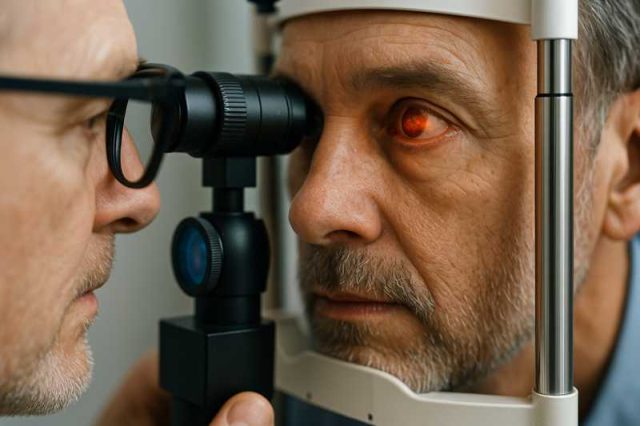Can too much glucose control actually harm the eyes? That’s the question raised by a recent study linking hypoglycemia to the worsening of diabetic retinopathy. For years, clinicians have prioritized tight glucose regulation to prevent complications. However, this new research suggests that frequent low blood sugar episodes might play a more damaging role in the progression of eye disease than previously understood.
Table of Contents
- Understanding Diabetic Retinopathy and Its Risks
- Study Insights: Hypoglycemia and Retinal Damage
- Implications for Diabetes Management Protocols
- Personalized Strategies to Reduce Complications
- Conclusion
- FAQs
Understanding Diabetic Retinopathy and Its Risks
Diabetic retinopathy is one of the most common microvascular complications of diabetes. It occurs when high blood sugar damages the blood vessels in the retina, leading to vision problems and, if untreated, blindness. Although it affects both type 1 and type 2 diabetes patients, those with longer disease duration or poor glycemic control are most at risk.
Currently, diabetic retinopathy is the leading cause of blindness among working-age adults worldwide. The progression of the disease is typically classified into non-proliferative and proliferative stages. In the early phase, patients may not notice symptoms. However, without regular screening and management, the disease can progress silently to more advanced stages.
For many years, the emphasis has been on preventing hyperglycemia to avoid retinal damage. But this new evidence points to a more complex relationship between blood sugar fluctuations and retinal health.
Study Insights: Hypoglycemia and Retinal Damage
According to findings published in a recent peer-reviewed journal, patients who experience frequent episodes of hypoglycemia may face a higher risk of developing or accelerating diabetic retinopathy. Researchers examined retinal scans and glucose logs from over 1,000 participants with type 2 diabetes. Those with consistent low blood sugar levels were more likely to show signs of retinal thinning, microaneurysms, and neovascularization.
The study theorizes that hypoglycemia-induced oxidative stress and endothelial dysfunction could contribute to microvascular damage in the retina. This damage may be compounded by impaired autoregulation of retinal blood flow in individuals with long-standing diabetes.
Although further research is needed to establish causality, the data underscores the need for more nuanced glucose targets. Especially in older adults or those with comorbidities, aggressive glycemic control could backfire.
For a closer look at similar studies and clinical implications, browse the expert features on Diabetes in Control.
Implications for Diabetes Management Protocols
This research could influence how providers approach blood sugar goals in diabetes care. Traditionally, tighter A1C targets have been associated with better long-term outcomes. However, in light of these findings, clinicians may need to balance the benefits of low A1C levels with the risks associated with hypoglycemia.
Updated care plans might include broader glucose target ranges for high-risk patients, such as the elderly or those with a history of severe lows. Tools like continuous glucose monitoring (CGM) devices can help detect dangerous patterns and allow for timely adjustments.
Medications that carry a lower risk of hypoglycemia, such as GLP-1 receptor agonists (e.g., Ozempic) or SGLT2 inhibitors (e.g., Jardiance), may become even more central to therapy. These agents not only lower blood glucose but also offer cardiovascular and renal benefits.
Importantly, patient education plays a key role. Encouraging individuals to recognize early symptoms of low blood sugar and adjust their lifestyle accordingly can make a significant difference.
For personalized treatment decisions, individuals should always consult a healthcare provider. When in doubt, platforms like Healthcare.pro can connect patients with qualified professionals.
Personalized Strategies to Reduce Complications
Individualized care has become the gold standard in diabetes management. In the context of diabetic retinopathy, this means tailoring interventions based not just on A1C goals, but also on personal risk factors, lifestyle, and comorbidities.
For instance, patients with existing eye disease may benefit from more conservative glucose targets to avoid exacerbating retinal damage. Regular retinal screenings using optical coherence tomography (OCT) and fundus photography are crucial for early detection.
Diet and exercise regimens should be balanced to prevent both highs and lows. Meal timing, carbohydrate intake, and physical activity schedules must be harmonized with medication regimens. Incorporating eye-friendly nutrients such as lutein, omega-3s, and vitamins C and E may also provide protective benefits.
Moreover, collaboration between endocrinologists, ophthalmologists, and primary care physicians ensures a holistic approach to care. The earlier patients and providers can spot trends in vision loss or glucose variability, the better the outcome.
To stay updated on patient-focused diabetes research, refer to the growing archive at Diabetes in Control.
Conclusion
The relationship between hypoglycemia and diabetic retinopathy progression is gaining more attention in clinical circles. While high blood sugar has long been blamed for retinal complications, new evidence reveals that frequent low blood sugar episodes may be just as damaging. As we move toward more personalized diabetes care, adjusting glucose targets and treatment strategies could help reduce the risk of long-term vision loss.
FAQs
Can low blood sugar really make diabetic retinopathy worse?
Yes. New research suggests that hypoglycemia may contribute to retinal damage by increasing oxidative stress and affecting blood vessel function.
Should I change my blood sugar goals because of this study?
Not on your own. Always speak with your healthcare provider before making changes to your treatment or target ranges.
How can I protect my eyes from diabetic complications?
Maintain consistent glucose control, get regular eye exams, and report any vision changes to your provider immediately.
Are certain diabetes medications safer for eye health?
Yes. Medications like GLP-1 receptor agonists and SGLT2 inhibitors pose a lower risk of hypoglycemia and may reduce other complications.
Where can I learn more about diabetic retinopathy?
Visit Diabetes in Control for the latest articles, or speak with your eye care professional.
Disclaimer:
“This content is not medical advice. For any health issues, always consult a healthcare professional. In an emergency, call 911 or your local emergency services.”
